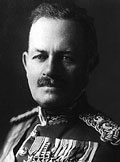Julian Byng was educated at Eton, and then began a career of cavalry officer serving in India and in the South African War (18991902). He was promoted to major general in 1909. Appointed (May 1916) to command the Canadian Army Corps in World War I, he directed it in the attack on Vimy Ridge, France, on 9 Apr 1917, and was promoted to command the British 3rd Army (June 1917). As army commander he conducted the first large scale attack by tanks in history (at Cambrai, 20 Nov 1917). His army broke the German Hindenburg Line on 27 Sep 1918. Byng was promoted to full general in 1917. In 1921, the first time the Canadian government was formally consulted about the selection of a governor general, Byng was a prominent nominee. Although Prime Minister Arthur Meighen preferred someone of civilian experience, Byng was finally chosen partly due to his popularity in Canada as a war hero. Byng traveled more than any of his predecessors, making extended trips to western Canada and the North. He established the Governor General's Cup at the Royal Agricultural Winter Fair and favored sports, especially ice hockey. The most notable issue during Byng's term of office was the "King-Byng Affair," which started after Byng refused the Liberal prime minister's request for a dissolution of Parliament. However, after a series of government crises the Liberals were returned to power with a clear majority and sought to redefine the role of Governor General. On 30 Sep 1926 Byng departed from Canada under a shadow without waiting for the inauguration of his successor, Viscount Willingdon. Following his term as governor general, Byng returned to England where he was raised in the peerage as Viscount. He served as Commissioner of the London Metropolitan Police (1928-1931) and was promoted to the rank of field marshal (1932). |

